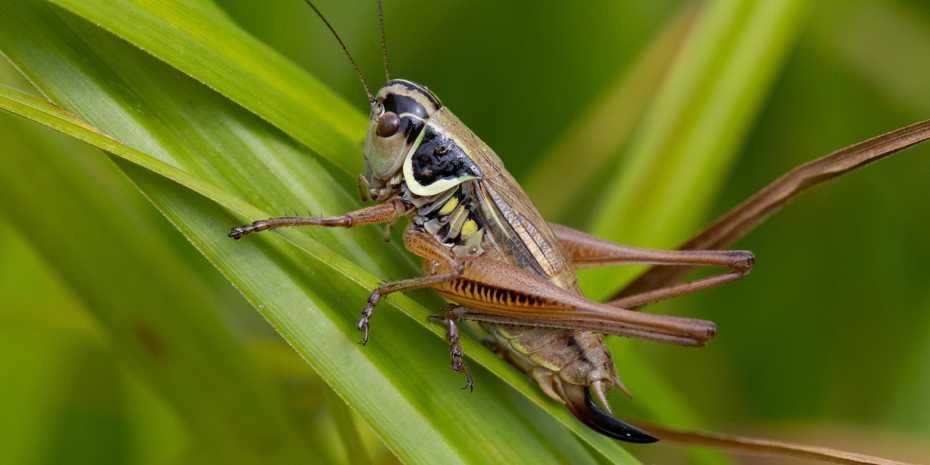Dec 18 2020
Planet Earth is getting warmer by the day, making several organisms native to lower elevations or latitudes move higher.
 Roesel’s bush-cricket is one of the many grasshoppers that might migrate to higher elevations once the climate in lower elevations has become unsuitable. Image Credit: Christian Roesti.
Roesel’s bush-cricket is one of the many grasshoppers that might migrate to higher elevations once the climate in lower elevations has become unsuitable. Image Credit: Christian Roesti.
When novel organisms move into a new habitat, they could influence the ecological balance that has been formed over a long period. Herbivores and plants are characterized by long-term co-evolution, which has shaped not only their geographic distribution but also the characteristics that they exhibit in their own habitats.
At higher elevations, insect herbivores have been found to be less abundant in general, leading to plants being less well-defended against herbivores, due to shorter growing seasons and lower energy.
On the contrary, plant species native to lower elevations safeguard themselves against more diverse and abundant herbivores by having thorns or hair, spikes, or toxic substances. This ecological organization could be affected by climate change.
Grasshoppers Translocated to High Elevations
Scientists from ETH Zürich, the Swiss Federal Institute for Forest, Snow and Landscape Research (WSL), and the University of Neuchâtel performed an experiment to see what could happen if herbivores—including different grasshoppers from middle elevations—settled in alpine meadows at higher elevations and came across new plant communities there. The study was published recently in the Science journal.
Different grasshopper species were translocated from middle altitudes (1,400 m above sea level) to three alpine grassland sites at elevations of 1800, 2070, and 2270 m above sea level, where the grasshoppers were placed in cages. The researchers removed local grasshoppers from the experimental areas before the experiment, which was performed in the Anzeindaz region in the Vaud Alps.
As part of the study, the team measured how the biomass, structure, and composition of the alpine plant communities varied under the impact of the herbivorous insects. They also analyzed whether certain plant species were more vulnerable to herbivory, for example, plants with tougher leaves, or those that contain more silica or other components like tannins or phenols.
Lowland Grasshoppers Influence Alpine Community
The ecologists found that the feeding behavior of the grasshoppers had a clear impact on the vegetation structure and composition of the alpine flora. Alpine communities exhibit clear structure in the organization of the canopy, where plants with tough leaves are at the top and more shade-tolerant plants with softer leaves are at the bottom.
However, there was an impact on this natural organization since the translocated grasshoppers tended to feed on taller and tough alpine plants, which had functional characteristics like leaf structure, chemical defense, nutrient content, or growth form analogous to those of their previous, lower-elevation food plants.
Thus, the insects decreased the biomass of dominant, tough alpine plants, thereby favoring the growth of smaller plant species avoided by the herbivores. This led to an increase in the overall plant diversity in the short term.
Immigrant herbivores consume specific plants in their new location and this changes and reorganises the competitive interaction between those alpine plant species.
Patrice Descombes, Study First Author, ETH Zürich
Global warming, for instance, could affect the ecological balance since mobile animals, such as the different species of herbivorous insects, can widen their habitat to higher elevations more quickly compared to sedentary plants.
Thus, herbivorous insects from lower altitudes could easily make their way into alpine habitats where resident plants are inadequately or completely not prepared to safeguard themselves against the new herbivores.
This could alter the existing structure and function of alpine plant communities as a whole. Thus, climate change would have an indirect effect on ecosystems, apart from the direct outcomes of increasing temperatures.
Important Drivers of Changed Ecosystems
According to Loïc Pellisier, Professor of Landscape Ecology at ETH Zürich and WSL, this indirect impact of climate change on ecosystems is one of the most crucial results to be obtained from the study.
Climate impact research has largely investigated the direct effects of temperature on ecosystems, but these novel interactions that arise between species moving into new habitats could generate important structural modifications. They are important drivers of changed ecosystems in an increasingly warm climate.
Loïc Pellisier, Professor of Landscape Ecology, ETH Zürich
Using the study results, the researchers intend to enhance models that have fallen short of completely integrating such processes until now. Moreover, they hope that this will enhance the prognosis of how climate change will affect the functioning of ecosystems and the services they offer.
Journal Reference:
Descombes, P., et al. (2020) Novel trophic interactions under climate change promote alpine plant coexistence. Science. doi.org/10.1126/science.abd7015.